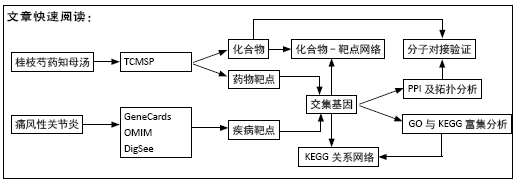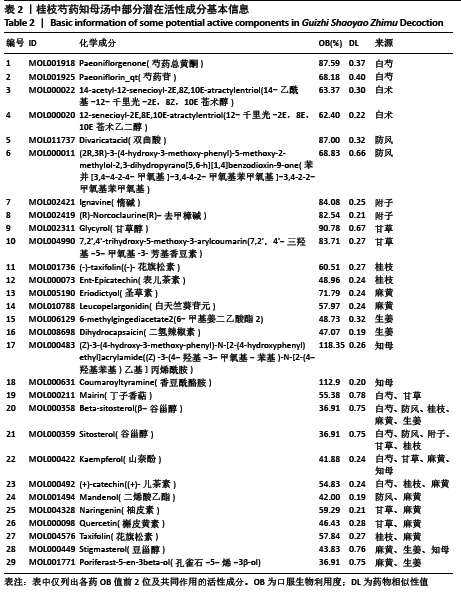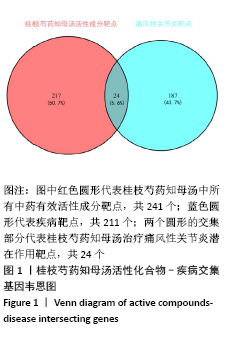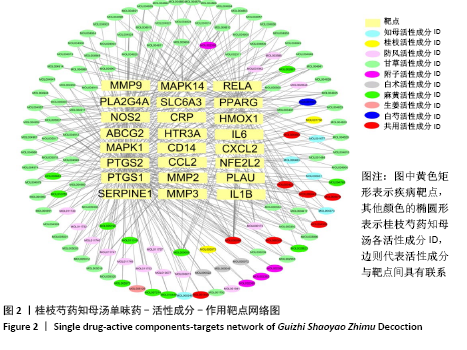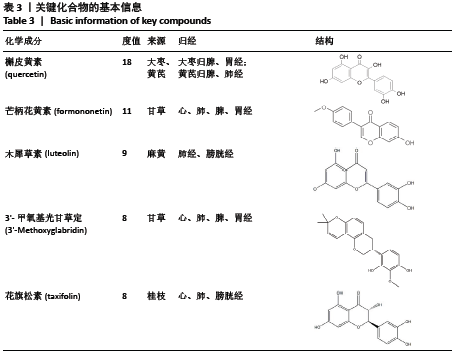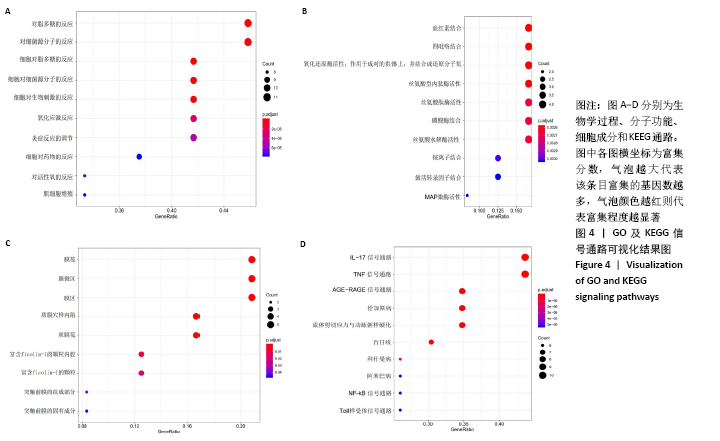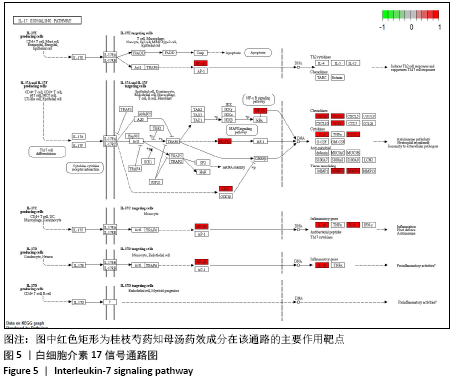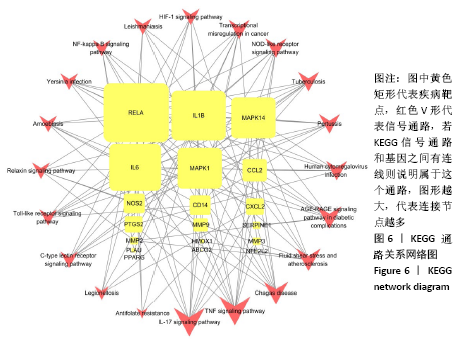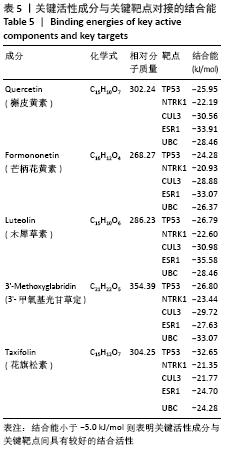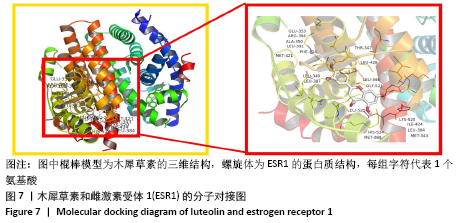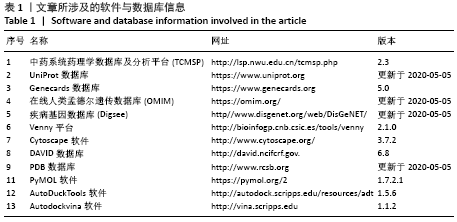[1] TATSIY O, MAYER TZ, CARALHO OLIVEIRA V, et al. Cytokine production and NET formation by monosodium urate-activated human neutrophils involves early and late events, and requires upstream TAK1 and Syk. Front Immunol. 2020. doi: 10.3389/fimmu.2019.02996.
[2] HSIEH CY, LI LH, LAM Y, et al. Synthetic 4-hydroxy auxarconjugatin b, a novel autophagy inducer, attenuates gouty inflammation by inhibiting the NLRP3 inflammasome. Cells. 2020;9(2):279.
[3] 舒建龙,李凤珍,覃裕旺.痛风病理及临床中西医治疗的研究进展[J].中国实验方剂学杂志, 2020,26(2):218-227.
[4] 黄 聪,彭伟,牟茂婷,等.基于“肢节痹病”的桂枝芍药知母汤的现代药理作用探讨[J].时珍国医国药,2019,30(4):949-950.
[5] 乔晓涵.桂枝芍药知母汤加减方治疗急性痛风性关节炎疗效观察[D].沈阳:辽宁中医药大学, 2019.
[6] LI G, XU Q, HAN K, et al. Experimental evidence and network pharmacology-based analysis reveal the molecular mechanism of Tongxinluo capsule administered in coronary heart diseases. Biosci Rep. 2020;40(10):BSR20201349.
[7] SAKLE NS, MORE SA, MOKALE SN. A network pharmacology-based approach to explore potential targets of Caesalpinia pulcherima: an updated prototype in drug discovery. Sci Rep. 2020;10(1):17217.
[8] ZHANG Q, LI R, PENG W, et al. Identification of the active constituents and significant pathways of Guizhi-Shaoyao-Zhimu decoction for the treatment of diabetes mellitus based on molecular docking and network pharmacology. Comb Chem High Throughput Screen. 2019; 22(9):584-598.
[9] 汪选斌,陆金健.中药药理规范研究的思考[J].世界科学技术-中医药现代化,2019,21(9):1846-1854.
[10] GUO Q, MAO X, ZHANG Y, et al. Guizhi-Shaoyao-Zhimu decoction attenuates rheumatoid arthritis partially by reversing inflammation-immune system imbalance. J Transl Med. 2016;14(1):165.
[11] ZHANG Q, PENG W, WEI S, et al. Guizhi-Shaoyao-Zhimu decoction possesses anti-arthritic effects on type II collagen-induced arthritis in rats via suppression of inflammatory reactions, inhibition of invasion & migration and induction of apoptosis in synovial fibroblasts. Biomed Pharmacother. 2019;118:109367.
[12] ZHANG KH, WANG MQ, WEI LL, et al. Investigation of the effects and mechanisms of dendrobium loddigesii rolfe extract on the treatment of gout. Evid Based Complement Alternat Med. 2020; 2020:4367347.
[13] ZHOU Q, SUN HJ, LIU SM, et al. Anti-inflammation effects of the total saponin fraction from Dioscorea nipponica Makino on rats with gouty arthritis by influencing MAPK signalling pathway. BMC Complement Med Ther. 2020;20(1):261.
[14] ZHOU M, ZE K, HUA L, et al. Cyr61 promotes inflammation of a gouty arthritis model in rats. Mediators Inflamm. 2020;2020:8298615.
[15] 李建,张洁瑛,孙鹏,等.平胃散合桂枝芍药知母汤加减治疗慢性痛风性关节炎的疗效机制[J].中国实验方剂学杂志,2018,24(1):180-185.
[16] RUIZ-MIYAZAWA KW, STAURENGO-FERRARI L, MIZOKAMI SS, et al. Quercetin inhibits gout arthritis in mice: induction of an opioid-dependent regulation of inflammasome. Inflammopharmacology. 2017;25(5):555-570.
[17] FU X, QIN T, YU J, et al. Formononetin ameliorates cognitive disorder via pgc-1α pathway in neuroinflammation conditions in high-fat diet-induced mice. CNS Neurol Disord Drug Targets. 2019;18(7):566-577.
[18] WANG S, CAO M, XU S, et al. Luteolin alters macrophage polarization to inhibit inflammation. Inflammation. 2020;43(1):95-108.
[19] LI P, LI Y, JIANG H, et al. Glabridin, an isoflavan from licorice root, ameliorates imiquimod-induced psoriasis-like inflammation of BALB/c mice.Int Immunopharmacol. 2018;59:243-251.
[20] 李想,李冀.甘草提取物活性成分药理作用研究进展[J].江苏中医药,2019,51(5):81-86.
[21] Wu SC, YANG ZQ, LIU F, et al. Antibacterial effect and mode of action of flavonoids from licorice against methicillin-resistant staphylococcus aureus. Front Microbiol. 2019;10:2489.
[22] YUAN X, LI N, ZHANG M, et al. Taxifolin attenuates IMQ-induced murine psoriasis-like dermatitis by regulating T helper cell responses via Notch1 and JAK2/STAT3 signal pathways. Biomed Pharmacother. 2020;123:109747.
[23] HAUGEN J, CHANDYO RK, BROKSTAD KA, et al. Cytokine concentrations in plasma from children with severe and non-severe community acquired pneumonia. PLoS One. 2015;10(9):e0138978.
[24] PISANI LP, ESTADELLA D, RIBEIRO DA. The role of toll like receptors (TLRs) in oral carcinogenesis. Anticancer Res. 2017;37(10):5389-5394.
[25] CHEN Y, WU D, SUN L. Clinical Significance of High-Mobility Group Box 1 Protein (HMGB1) and Nod-Like Receptor Protein 3(NLRP3) in Patients with Ulcerative Colitis. Med Sci Monit. 2020;26:e919530.
[26] FREUDENSTEEIN D, LITCHFIELD C, CARAMIA F, et al. TP53 status, patient sex, and the immune response as determinants of lung cancer patient survival. Cancers (Basel). 2020;12(6):1535.
[27] DONG Z, CHEN W, CHEN C, et al. CUL3 deficiency causes social deficits and anxiety-like behaviors by impairing excitation-inhibition balance through the promotion of cap-dependent translation. Neuron. 2020;105(3):475-490.
[28] EDREES MAH, LUO J, SUN F, et al. Ubc9 deficiency selectively impairs the functionality of common lymphoid progenitors (CLPs) during bone marrow hematopoiesis. Mol Immunol. 2019;114:314-322.
[29] 黄聪,彭伟,牟茂婷,等.基于“肢节痹病”的桂枝芍药知母汤的现代药理作用探讨[J].时珍国医国药,2019,30(4):949-950.
[30] SAKELLARIOU G, SCIRE CA, ADINOLFI A, et al. Differential diagnosis of inflammatory arthropathies by musculoskeletal ultrasonography: a systematic literature review. Front Med (Lausanne). 2020;7:141.
[31] FENG K, CHEN Z, PENGCHENG L, et al. Quercetin attenuates oxidative stress-induced apoptosis via SIRT1/AMPK-mediated inhibition of ER stress in rat chondrocytes and prevents the progression of osteoarthritis in a rat model. J Cell Physiol. 2019;234(10):18192-18205.
[32] CHO IA, KIM TH, LIM H, et al. Formononetin antagonizes the interleukin-1β-induced catabolic effects through suppressing inflammation in primary rat chondrocytes. Inflammation. 2019;42(4):1426-1440.
[33] FEI J, LIANG B, JIANG C, et al. Luteolin inhibits IL-1β-induced in?ammation in rat chondrocytes and attenuates osteoarthritis progression in a rat model. Biomed Pharmacother. 2019;109:1586-1592.
[34] YAMAMOTO S, IWAKUMA T. Regulators of oncogenic mutant TP53 gain of function. Cancers (Basel). 2018;11(1):4.
[35] UHLMANN C, KUHN LM, TIGGES J, et al. Efficient modulation of TP53 expression in human induced pluripotent stem cells. Curr Protoc Stem Cell Biol. 2020;52(1):e102.
[36] CAO L, BASUDAN A, SIKORA MJ, et al. Frequent amplifications of ESR1, ERBB2 and MDM4 in primary invasive lobular breast carcinoma. Cancer Lett. 2019;461:21-30.
[37] KONG Y, WANG Z, HUANG M, et al. CUL7 promotes cancer cell survival through promoting Caspase-8 ubiquitination. Int J Cancer. 2019;145(5):1371-1381.
[38] HWANG HS, LEE MH, CHOI MH, et al. NOD2 signaling pathway is involved in fibronectin fragment- induced pro-catabolic factor expressions in human articular chondrocytes. BMB Rep. 2019;52(6):373-378.
[39] PAN H, DAI H, WANG L, et al. MicroRNA-410-3p modulates chondrocyte apoptosis and inflammation by targeting high mobility group box 1 (HMGB1) in an osteoarthritis mouse model. BMC Musculoskelet Disord. 2020;21(1):486.
[40] 吴剑静,胡洛爽,叶天申,等.桂枝芍药知母汤加减结合微针刀治疗急性痛风性关节炎疗效观察[J].实用中医药杂志,2020,36(3):279-280.
[41] LI R, JIA Z, ZHU H. Regulation of Nrf2 signaling. React Oxyg Species (Apex). 2019;8(24):312-322.
[42] YANG SC, CHEN PJ, CHANG SH, et al. Luteolin attenuates neutrophilic oxidative stress and inflammatory arthritis by inhibiting Raf1 activity. Biochem Pharmacol. 2018;154:384-396.
|
